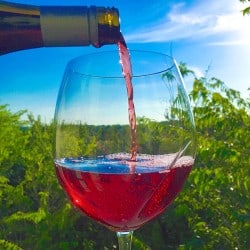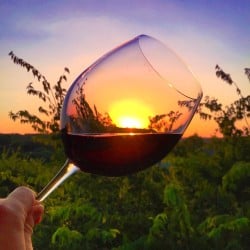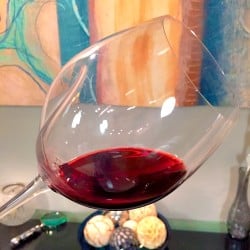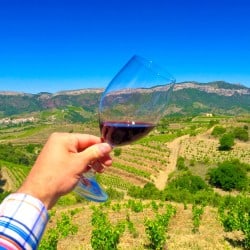Menu (click to skip to any of the below sections)
- The Basics (Short Version of Wine Tasting and Steps Involved)
- How to Taste Wine – Preparing Your Body and the Environment
- Step 1: Observing the Wine (Advanced)
- Step 2: Smelling the Wine (Advanced)
- Step 3: Tasting the Wine (Advanced)
Wine tasting can be an enlightening process if done correctly. In fact, even if you screw up, it’s still an awesome experience! It can even make you smarter. After all, you’re exposing your mind to new flavors and aromas and forcing yourself to look at wine critically. Which is a lot more fulfilling and fun!
I can’t tell you how many of my friends tell me “all red wine tastes the same,” or “as long as it’s not too sweet I’ll drink it.” That’s all well and good, but unfortunately, if this is your style, you’re missing out on a whole separate dimension in the way of truly enjoying wine.

The Basics
Step 1: Look
Pick up your glass and swirl it around. Take a look from above, from the side, and then tilt it against the light in front of a white background. Attempt to determine age, grape variety, climate and alcohol content.
A couple of examples: The more “legs” or “tears of wine” you see riding down the side of the wine glass, the more alcoholic the wine is. If you pick up amber or orange colors along the rim of a red wine, the older it is. Purple hues indicate youth in red wine.
Step 2: Sniff
Choose a glass that allows you to get your entire shnozz into it.
First, check for pungent odors along the lines of moldy basement, mildew, rustic brick, fish market and vinegar. These could be flaws.
Then, check for dominant fruit aromas. With white wines, think tree, tropical and or citrus fruit. For red wines, think red fruit, black fruit and blue fruit.
Next, check for secondary hints of flowers, spice and other herbaceous characteristics.
Now, smell for earthy notes. Think about decaying leaves, mineral hints (chalk, limestone, clay).
Once you’ve established primary scents of fruit, secondary aromas of earth, check for evidence of oak barrel aging (caramel, vanilla, oak, cream and butter).
Lastly, feel for heat based intensity in your nostrils due to high alcohol content.
Step 3: Taste
On the tasting portion, you’re going to make an effort to reaffirm everything you just saw and smelled.
First, you’re going taste for sweetness and or dryness.
Second, you’re going to taste for balance across the palate.
Now, focus on the body. Is it light, medium or full-bodied?
Next, you’re tasting for primary fruit flavors. Do you detect red, black or blue fruit? If so, which ones specifically?
Now search your palate for secondary flavors that may give off hints of vegetables, flowers or spice box.
Look for hints of earth reminiscent of dried leaves or chalky minerals, clay or slate.
Are your taste buds standing on end or does the side of your mouth feel gritty? If so, the wine you’re drinking is probably somewhat tannic.
Now, search your mouth for acidity. Do you get any tart, sour flavors or a mouth-water sensation?
Once you’ve been able to detect evidence of acid, now it’s time to determine whether or not the wine has elevated or low alcohol. Do you feel heat or warmth in the back of your throat or chest?
How complex is the glass you’re sipping? Is it boring, one-sided on the fruit front? Or is it loaded with several styles of fruit, earth and tertiary flavors?
Finally, taste for the finish. Does the wine go down your throat with the flavor dissipating immediately? Or does the aftertaste linger for several minutes?

How to Taste Wine (Advanced)
Utilize the Right Environment, Prepare Your Body and Use the Right Wine Glasses
Before you even get to pouring a glass of your favorite vin, make sure that your environment is conducive to wine tasting. That means make sure you didn’t just bake a cake, brush your teeth or use mouthwash.
Foreign aromas (like perfume or baked cookies), despite how comforting they may be, will make any attempt to taste wine properly null and void. At the same time, you shouldn’t have any pungent flavors clinging to the taste buds on your tongue either. Make sure your mouth is clear of recent cleansing agents or otherwise clingy flavors unrelated to wine.
Ensure that you’re using natural light, if at all possible. It’s also best to use a white background for the visual portion of your wine tasting. Laying pieces of white paper on the table is an easy way to achieve this.
Equally as crucial, make sure you’re using the right sized, CLEAN wine glasses. Note that if you’re cleaning the glasses immediately before a tasting, make sure there’s no residual water left in the glass. This matters despite what style of wine you’re about to taste.
Champagne flutes are NOT ideal if you’re sampling champagne, as the rim is too small to get a good whiff of the wine. For reds, use big-basined glasses that narrow slightly towards the top. A glass with a big basin, that also narrows at the top will allow for aromas to release yet at the same time get trapped. Just make sure they aren’t too narrow or you won’t be able to get your nose inside!
Lastly, remember that the condition of the wine itself will have an impact on scent and flavor. If the wine is older, the scent will be considerably different than that of a younger wine made from the same grape variety. Also, if a wine is chilled, flavor nuances and aromas can appear muted. Try to make sure that your lineup of whites and reds are tasted at the same temperature, respectively.
*Pro-tip* – Just so you know ahead of time – if you’re serious about tasting wine like a true professional, you shouldn’t actually swallow after you sip. Master Sommeliers and other wine professionals will swish the wine in their mouths, and then spit it out. I’m not going to go into detail about why this is done, but I’ll leave you with a hint. Drinking wine gets you drunk. Deductive reasoning can become impaired, especially if you’re a Somm tasting over 50 wines per day. YMMV.

Step 1 – Observe the Wine in the Glass
Believe it or not, the first step in the process of tasting wine has nothing to do with tasting wine. That’s right. You’re going to observe the hell out of that liquid first. But what’s the point? Well, observing a wine in the glass can tell you a lot about it – without even tasting it for yourself.
How:
First, fill a little bit less than a quarter of a *stemmed-glass* with whichever wine you’re looking to taste. Grab the glass near the top of the stem, as holding the actual basin can subtly distort the flavor and aroma of the wine through the warmth of your hands.
Next, gaze at the wine with your eyes directly above the glass. This will allow you to get a good clean view of the rim and body color of the wine. Both offer indications of age, terroir, and grape variety.
Afterward, take a look at the wine through the side of the glass for another perspective.
After a side-view, hold the glass by the stem near a source of natural light with a white background.
Lastly, swirl the wine around the inside of the glass and observe again.

What to look for:
Check for Age
An older, old-world red wine will appear more rustic-red, orange and sometimes opaque when compared to a younger, new-world red wine. Younger red wines will almost always contain more purple hues.
Note that ‘Old World’ and ‘New World’ when it comes to color is still a controversial subject. If you’re tasting around professionals it may be better to attribute age-related color attributes to age itself, rather than also integrating geography.
White wines change color as they age as well. They’ll acquire more mustard and dark yellow hues. Just make sure they aren’t starting to look brown! That could be an indication that your white wine has expired.
*Pro-tip* – The older the wine, the more variation in color you’ll find between the rim and center of the glass.
Also note that wines that have been improperly stored within inconsistent temperature conditions can dramatically impact the color, and quality of the wine. Poor corkage or temperature contributes to premature and accelerated oxidation.
Check for Alcohol and Sugar
Do you see any “tears of wine” (otherwise known as ‘legs’) dripping down the inside of your wine glass? That’s an indication of how alcoholic the wine is. There are two main indicators as to how much alcohol and sugar a wine has. First, the more alcohol in a glass of wine, the longer and more abundant the legs will be. Second, the more residual sugar, the slower those “tears” will fall.
Check for Climate
Cooler climate wines will often be lighter in color and contain less alcohol. For whites, you may notice some green hues and soft straw colors around the rim. For reds, you’ll see more thin ruby or garnet, as opposed to deep purple or rich ruby red. Note that this is also a subject that is controversial. There are exceptions to these rules, and the Vinho Verde wines offer a classic example given their color.
Check for Clarity
You’re basically checking to see whether or not the wine has been filtered before bottling. If the wine is clear with minimal sediment and clouds floating around, there’s a good chance it has been filtered. If it’s cloudy, it could be unfiltered, or there could be a problem with the bottle itself. You’ll know during the next step if the wine itself has gone bad.
Also worth noting is that many well-known producers don’t filter their wines. The finest producers employing the most rigid winemaking practices can still come up with a product that is surprisingly clear despite it being unfiltered.
Attempt to Determine Grape Variety
This is one of the more difficult things to determine simply by looking at the wine. At the end of the day, you’ll need to go through ALL of the steps to really come to a firm conclusion on grape variety. It’s difficult considering how much age and climate can affect a wine’s color. However, there are a few basic generalizations that can point you in the right direction.
New World Napa Cabernet will often have a rich ruby red color to it.
Malbec will often have a deep purple, almost black, and inky core to it, with purple and violet closer to the rim.
Merlot tends to appear more translucent and slightly orange around the rim when compared to Cabernet Sauvignon.
Thinner-colored red wines include Grenache and Pinot Noir
Step 1 Summary:
Did you attempt to observe the age of the wine?
Did you look at the alcohol and sugar content?
Have you discovered what climate (hot or cool) the wine came from?
Were you able to determine the grape variety?
Note – if you’re not able to determine some, all, or any of the above. That’s okay. Most industry professionals need to go through all of the steps before they can come to a solid conclusion. Plus, your tasting skills will improve in time. What does matter is that you made an honest attempt, and hopefully you found the process enjoyable.

Step 2 – Smell the Wine (Nose)
There are a few ways to go about this, and there’s no one correct way. You can either take several ‘short-burst’ sniffs of the wine while sticking your nose deep within the glass. You can also take one long whiff (my personal preference).
Check For Potential Flaws
During your first initial sniffs, you’re going to be checking to see whether the wine is good or bad.
One of the most common flaws is when the bottle is “corked.” The official term is cork taint, and it happens when the liquid in a bottle becomes contaminated with the chemical compound TCA (2,4,6 – trichloranisole). This compound is created when microorganisms get into the cork either before the bark is harvested, before or after a cork has been inserted into the bottle. Essentially, they create the byproduct TCA which can leech into the wine. The result is a moldy, ancient and wet basement smell. It’s pretty unmistakable.
I recently had a bottle of Primitivo that was corked, and it smelled like decaying fish. Luckily, only about 1 in every 100 bottles of wine typically contains cork taint. Better still, with new styles of metal bottle stoppers and synthetic corks, cork taint may one day become a thing of the past. Even some famous Chateau’s in Bordeaux are starting to experiment with synthetic corks and metal bottle stoppers. One of them is Chateau Margaux.
Other flaws can occur too.
Wines can become over-oxidized, which leaves a rustic, sort of burnt metal smell in your nose. Also, volatile acidity will leave you with strong hints of vinegar. Other yeast-based flaws can occur too that dramatically shift a wine’s scent away from any floral or fruity aromas and divert it towards your grandma’s old leather chair.
Check For Fruit Aromas
Next, you’re going to focus on determining the fruit flavors present in a bottle of wine. There are a few dozen aromas and they vary depending on the varietal(s) you may be tasting. For the sake of keeping this simple, see below for Master Sommelier Tim Gaiser’s assessment of common fruit aromas associated with both white and red wines. These scents primarily occur dependent upon the grape variety and the climate it’s grown in.
White wines:
Tree fruit: apple and pear
Citrus fruit: lemon, lime, grapefruit, orange, tangerine and the like.
Tropical fruit: pineapple, mango, papaya, passion fruit, banana etc.
Stone or pit fruit: peach, apricot, nectarine
Red wines:
Red fruits: red cherry, red raspberry, cranberry, strawberry, red currant, red plum, pomegranate.
Black fruits: black cherry/berry, black currant, black raspberry, black plum and in even riper versions boysenberry and blueberry.
Dried or desiccated fruit: raisin, date, prune, fig
Note that the above fruits do not represent every possible outcome. In some cases, fruit aromas may seem to meld or blend with one another, in other cases, perhaps you’ve had some form of exotic fruit that better defines the wine to you. This brings me to my next point – wine tasting is really a subjective practice. If you haven’t been exposed to boysenberry before, how could you possibly say it smells like one? Try your best to assess wines based on what you know. If you don’t know enough, get out there and stick your nose in more stuff.
Check For Flowers, Spice & Herbaceous Aromas
Present in both red and white wines, these are commonly referred to as secondary aromas, and they accompany the fruits mentioned above.
Check For Earthy Evidence
One of my personal favorite parts about a wine is when it evokes a part of the terroir from whence it sprang. New World wines, like a young Napa Cabernet Sauvignon, tend not to have many noticeable earth tones. On the other hand, some of my favorite old world wines from Bordeaux are commonly loaded with both mineral (flint, schist, limestone, clay) and earth (wet forest floor, barnyard door, dried violet, tumbleweed, mushroom) scents.
Check For Barrel Aging
The longer a wine is aged in oak, the more pronounced caramel, vanilla, mocha and smoke notes you’ll be able to detect. At the same time, if the wine is older, you’ll notice more earth tones than you will fruit-forwardness.
Check For Alcohol
If you already witnessed some lengthy legs in your visual assessment, you’ll likely feel a slight burn on your nostrils if the wine is somewhat alcoholic.
Step 2 Summary:
Did you check for flaws in the wine?
Did you check for primary fruit aromas?
Did you check for secondary floral and herbaceous aromas?
Did you check for barrel aging?
Did you check for earth and mineral scents?
Did you reaffirm your assessment of alcohol content?

Step 3 – Taste the Wine
Finally, we can get to sipping. Yes, I said sipping. If you’ve made it this far, you should savor every sip and use your sense of taste to the best of your ability.
At this point, what you’re basically doing is reaffirming some of the conclusions you may have come to in the first two steps.
Taste For Dryness and or Sweetness (Alcohol vs. Sugar)
Sometimes there’s no clear-cut answer for this. The first thing I must make clear – just because a wine may taste ‘fruity’ does not necessarily mean it’s sweet! Sugar has a distinct taste, and the viscosity (or consistency in thickness of the liquid) will often be high if a wine contains a significant amount of sugar. Dry wines have a low viscosity and won’t taste sweet (but remember, they may taste fruity!)
*Pro-tip* – ‘New World’ Cabernet Sauvignon, especially those from Napa Valley are often very fruit-forward, but still remain quite dry. Occasionally, blends concocted in the same region can also come across as sweet, but it’s actually just our perception. Keep this in mind while you taste any New World variations!
Taste For Balance
Part of the reason why we taste wine last and not first is that our taste buds are actually somewhat limited in what they’re capable of. Our nose can detect far more variations in aromas than our mouths can in taste. Our taste buds are limited to sweet, sour, salty, and bitter.
That being said, check to ensure that from the first second the wine touches your tongue, to the aftertaste, that there’s some form of consistency between all four flavors. Is there an overload of fruit? Is there too much acid on the opening palate? Is there an overpowering earthiness that takes away from the fruits? You’ll know you have a great wine when they all meld together as liquid perfection.
Check For Body
This is a biggy. For many of us, body helps us determine what type of grape varieties we truly favor. At this point, you’re trying to figure out whether your glass feels light-bodied, medium-bodied, or full-bodied throughout the palate. Let me put this in perspective for you on a red wine variety scale:
Pinot Noir is typically light-bodied. Merlot is more medium-bodied, and Cabernet Sauvignon is typically full-bodied. You could also call this tasting the ‘weight’ of the wine. A skill that doesn’t come immediately, but once you start attempting to hone it, it’s the first you’ll master when it comes to the actual tasting portion of the wine tasting practice.
Taste For Fruit
Now we get to the fun part. Remember all that fruit and herb sniffing you did not too long ago? You’re going to be looking for those flavors on your tongue… plus more. Again, you’re attempting to reaffirm your sense of sight and scent!
If you’re drinking red wine, look for cherries, pomegranate, blackberry, raspberry, plums, tomatoes, cranberry, cassis and red currant.
If you’re drinking white wine, look for melon, lemon, lime, mango, white peach, pear and grapefruit.
Did none of those fruits line up with what you tasted? Dig into your memory bank and try to think of fruits you’ve tried in the past. What does the wine taste like to you? Remember, wine tasting is subjective.
Taste For Veggies, Spice & Flowers
Do you get some hints of green bell pepper on that Carménère (one of my favorite varieties commonly found in Chile)? How about some strong hints of tobacco on that Nebbiolo? These are all secondary flavors you’re looking to detect across the palate. Think about spices, herbs, flowers, candy and even cola-esque flavors you may be acquainted with. There’s no ‘set’ style of secondary flavor.
Taste For Earth
Remember how we briefly talked about that aroma of barnyard door? Well, now you’re going to be looking for something similar on the palate. Unless you played a lot of street hockey like me, you probably haven’t tasted too much clay. Regardless, you can imagine what sort of gritty and chalky flavor something like clay or limestone would be like in your mouth. Conversely, if you’ve done a lot of hiking, you might get a sense for what an old forest smells like and can therefore associate it with a taste. You’re going to be looking for those earthy nuances at this stage in your tasting.
Feel For Tannins
Ahhhh, one of my favorite aspects of wine tasting. Tannins are an organic compound that can be found in grape skins, grape seeds, bark and the wood of the barrels many wines are commonly aged in. You might notice that I used the word ‘feel’ in the above heading. That’s because tannins don’t actually have much flavor. In fact, they react with the protein compounds in your mouth and create an astringent feel. If you feel the taste buds on your tongue or the cells on the side of your mouth stand on end, then the wine is somewhat, or very tannic. You’ll usually find a much more concentrated tannin content within a glass of red wine than you will with white wine. These compounds add complexity to the wine, while at the same time helping to preserve the wine over time as it ages.
Taste For Acidity
Acidity is exactly what it sounds like. Try to think about tart or somewhat sharp flavor nuances. Increased salivating (that mouth-watering sensation) is also a common indication of acid. No matter what grape variety you’re drinking, every style of wine has some concentration of acid that balances out the rest of the flavor. It’s also another crucial component for aging wine.
Elevated acid in wine compliments fatty foods well, and also encourages your mouth to want another sip!
*Pro-tip* – Many people confuse acidity with tannins. There’s an easy way to remedy the confusion. Just remember that acid is more flavor-based and saliva-encouraging, while tannins cause a sensation in the form of astringency.

Taste For Alcohol Content
Alcohol at this point is somewhat easy to detect. If you saw a lot of legs and partially burnt your nose hairs off before you tasted a glass, you should have made the assumption that the wine has an elevated alcohol content. Do you feel any burning or ‘hot’ sensation in the back of your throat? If you do, then you’ve likely reaffirmed that the glass you’re drinking has a substantial ABV.
Taste For Complexity
After all of the taste testing you’ve done above, how many flavors, feels and ‘3dness’ do you actually notice? If a wine seems to only have one fruit flavor and very little earth or acid, then not only is it unbalanced, but it’s not very complex.
Complexity deals with how many flavoric nuances dance across your tongue as you drink your glass from start to finish. It’s different from balance, because a wine can be balanced and only have a few flavors. A complex AND balanced wine is a masterpiece.
The Finish Line
You’ve almost made it. Now, how does the wine go down at the end of the palate? Does it stick in the back of your throat for a long time? Or does it go down within a split second with very little aftertaste?
If it’s somewhere in between, then you have a medium finish. Typically, the best wines have longer finishes. It’s great to savor what you love, right?
Step 3 Summary:
Did you taste for dryness and sweetness?
Did you taste for balance?
Did you taste for body?
Did you taste for fruit flavors?
Did you taste for veggie, spice and floral notes?
Did you taste for earth and mineral flavors?
Did you feel for astringency (tannins)?
Did you taste for acidity?
Did you taste for alcohol content (ABV)?
Did you taste for complexity?
Did you figure out the finish?

Step 4 – Lay Down Your Cards
Okay, so you’ve gone through the three main steps to tasting wine. Now it’s time to determine what you think it is. For Master Somm’s, this entails a lot of answers. They can usually pinpoint the vintage, climate, exact region (there are thousands), barrel aging and quality.
If you’re just throwing a fun wine tasting party, we can stick with grape variety, dominant flavors, and make an attempt at region and or vintage. Better yet, just rate the wines you liked the best in order! Good luck with your tasting endeavors and never shy away from a challenge! There are literally thousands of grape varieties out there. When you throw blends and various wine making techniques into the equation, you can be sure that you’ll never run out of new wines to taste.
Additional sources include The Court of Master Sommeliers, Legs & Lees

[…] When you go wine tasting, there is a science to it. The “correct” way to do it is: look, sniff, swirl, sip. I’m not a professional by any means, so check out this article to find out more. […]